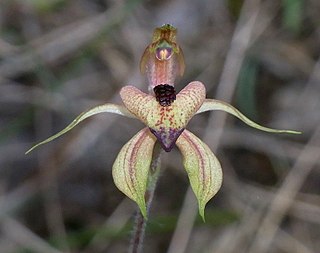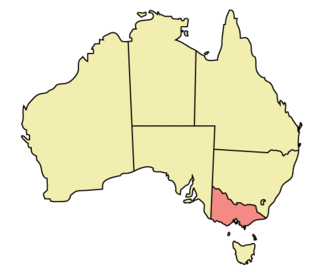Caladenia robinsonii, commonly known as the Frankston spider orchid is a plant in the orchid family Orchidaceae and is endemic to Victoria. It is a ground orchid with a single hairy leaf and one or two red and creamy-yellow flowers with dark red glandular tips on the sepals. In 2010 only about forty specimens of this plant, growing in a single population were known.

Caladenia dilatata, commonly known as the green-comb spider orchid and as koolin in indigenous language, is a plant in the orchid family Orchidaceae and is endemic to south-eastern Australia. It has a single leaf and a single yellowish-green flower with reddish stripes and occurs in Victoria and Tasmania. It is similar to C. necrophylla which occurs in south-east South Australia and to C. concinna from southern New South Wales.
Caladenia amoena, commonly known as the charming spider orchid, is a plant in the orchid family, Orchidaceae, and is endemic to Victoria. It is a ground orchid which grows singly or in small groups, has a single dark green, hairy leaf and a single yellowish-green flower with red stripes. It is only known from a few sites and has been classified as Endangered.
Caladenia brachyscapa is a plant in the orchid family Orchidaceae and is native to Victoria and possibly Clarke Island in Bass Strait. It is a ground orchid with a single hairy leaf and a reddish-pink flower with thick, black, club-like swellings on the petals and sepals. Although formally described in 1988 living specimens have not been observed since 1979.
Caladenia brumalis, commonly known as winter spider orchid, is a plant in the orchid family Orchidaceae and is endemic to South Australia. It has an erect, hairy leaf and usually a single white to pinkish flower with darker markings. It is only found in a few places due to habitat loss and is considered to be vulnerable.
Caladenia calcicola, commonly known as the Bats Ridges spider orchid, is a plant in the orchid family Orchidaceae and is endemic to a small area near the Victoria - South Australia border. It is a ground orchid with a single hairy leaf and one or two glossy, pale yellow flowers with maroon markings.

Caladenia cardiochila, commonly known as thick-lipped spider-orchid, fleshy-lipped caladenia and heartlip spider-orchid, is a plant in the orchid family Orchidaceae and is endemic to Victoria and South Australia. It is a ground orchid with a single hairy leaf and one or two yellowish-green, red-striped flowers on a thin, wiry stem.

Caladenia clarkiae, commonly known as pink caps, is a plant in the orchid family Orchidaceae and is endemic to south-eastern Australia. It is a ground orchid which grows singly or in small groups in Victoria and New South Wales. It has a single leaf and usually one or two white to pale pink flowers with darker pink tips.
Caladenia colorata, commonly known as coloured spider-orchid, small western spider-orchid and painted spider-orchid is a plant in the orchid family Orchidaceae and is endemic to South Australia and possibly Victoria. It is a ground orchid with a single hairy leaf, and usually a single creamy-green flower with blood-red or purple-brown markings and with dark tips on the petals and sepals.
Caladenia flaccida, commonly known as the flaccid spider orchid, is a plant in the orchid family Orchidaceae and is endemic to eastern Australia. It is a ground orchid with a single hairy leaf and up to three cream-coloured, pinkish or red flowers with long, thread-like, glandular tips on the sepals and petals.

Caladenia hillmanii, commonly known as purple-heart fingers, is a plant in the orchid family Orchidaceae and is endemic to New South Wales. It is a ground orchid with a single leaf and one or two bright pink flowers with a reddish-purple labellum with darker bars.
Caladenia osmera is a plant in the orchid family Orchidaceae and is endemic to south-eastern Australia. It is a ground orchid with a single leaf and one or two greenish-cream flowers with pink stripes and which has a sharp odour resembling burnt plastic.

Caladenia phaeoclavia, commonly known as the brown-clubbed spider orchid is a species of orchid endemic to New South Wales. It has a single, hairy leaf and a single light to dark green flower with red stripes and thick, brownish club-like tips on the sepals.
Caladenia pumila, commonly known as the dwarf spider orchid is a plant in the orchid family Orchidaceae and is endemic to Victoria. It is a ground orchid with a single erect, hairy leaf and a single white flower with pale pink stripes. Its short flowering stem distinguishes it from other Victorian spider orchids. After 1933 it was presumed extinct until two plants were discovered in 2009.

Caladenia reticulata, commonly known as the veined spider orchid, is a plant in the orchid family Orchidaceae and is endemic to Victoria and South Australia. It is a ground orchid with a single, hairy leaf and usually only one yellowish-green and red flower.

Caladenia verrucosa, commonly known as the mallee spider orchid, is a plant in the orchid family Orchidaceae and is endemic to south-eastern Australia. It is a ground orchid with a single, hairy leaf and usually only one greenish-yellow and red flower.
Caladenia rigida, commonly known as the stiff spider orchid, or white spider-orchid is a plant in the orchid family Orchidaceae and is endemic to South Australia. It is a ground orchid with a single hairy leaf and one or two white flowers with dark glandular tips on the sepals and fine reddish-brown lines along the sepals and petals.

Caladenia tensa, commonly known as the rigid spider orchid is a plant in the orchid family Orchidaceae and is endemic to southern continental Australia. It is a ground orchid with a single leaf and one or two pale green flowers with red stripes. It is mainly only found in the Little Desert National Park in Victoria and in the far south-east of South Australia but there are four records from New South Wales.

Caladenia valida, commonly known as the robust spider orchid, is a plant in the orchid family Orchidaceae and is endemic to south-eastern continental Australia. It is a ground orchid with a single sparsely hairy leaf and up to three white to cream-coloured flowers which sometimes have red streaks. It is similar to Caladenia reticulata but is large and taller with more stiffly spreading lateral sepals and petals.

Caladenia vulgaris, commonly known as summer fingers, or slender pink-fingers is a species of orchid endemic to southern Australia. It has a single, long, erect, hairy leaf and one or two pink or whitish flowers.





















